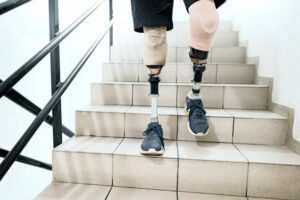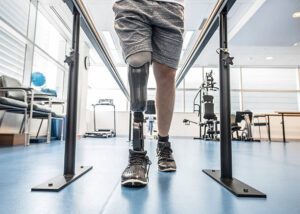When Should Amputation Be Considered? A Comprehensive Guide

For many, the concept of amputation is daunting and often considered a last resort in medical treatment. Yet, for some patients, it becomes a necessary step in their healthcare journey. This comprehensive guide aims to demystify the reasons behind amputation recommendations, what to expect during the process, and how to thrive afterward. Our target audience includes patients, caregivers, and medical professionals who seek a clearer understanding of this significant medical decision.
Understanding Amputation as a Last Resort in Medical Treatment

Amputation is often perceived as an extreme measure, only considered when all other treatment options have been exhausted. It involves the surgical removal of a limb or part of a limb and is typically recommended to preserve a patient’s quality of life. The decision is not taken lightly, as it impacts a patient’s physical and emotional well-being.
Healthcare professionals consider amputation when there is a significant risk to a patient’s health if the affected limb is not removed. It’s vital for patients and caregivers to understand that this decision is made with the utmost care and consideration of the individual’s circumstances.
Conditions Necessitating Amputation
Several medical conditions can necessitate amputation. Severe trauma, such as from an accident, can damage a limb beyond repair. In other cases, chronic conditions like diabetes may lead to poor circulation and tissue death, making amputation necessary to prevent infection.
Cancerous tumors in the bones or muscles may also require amputation to stop the spread of cancer. Additionally, congenital disabilities or severe infections that don’t respond to treatment may leave amputation as the only viable option.
Understanding these conditions helps patients and caregivers better grasp why amputation might be recommended and underscores the importance of early intervention and treatment.
The Decision-Making Process
The decision to amputate is complex and involves multiple factors. Medical professionals weigh the risks and benefits of the procedure, considering the patient’s overall health, the likelihood of recovery, and potential complications.
Patients and their families are active participants in this decision-making process. Open communication with healthcare providers is crucial, allowing individuals to express their concerns and preferences. This collaborative approach ensures that the decision aligns with the patient’s values and goals.
Ultimately, the goal is to choose a path that offers the best chance for a healthy and fulfilling life.
Alternative Treatments and Their Efficacy
Before recommending amputation, doctors explore all possible treatment options. These may include surgeries to repair or reconstruct damaged areas, medications to manage symptoms, or therapies to improve circulation and promote healing.
While these alternatives can be effective, they are not always viable for every patient. It’s essential to discuss these options with a medical team to understand their potential benefits and limitations fully.
Exploring alternatives empowers patients to make informed decisions and provides reassurance that amputation is indeed the last resort.
Preparing for Amputation
Preparation for amputation involves both psychological and physical readiness. Patients and caregivers must address emotional challenges, such as fear, anxiety, and grief. Support groups and counseling can be invaluable during this time.
Physically, patients may undergo pre-operative assessments and rehabilitation to strengthen their bodies for surgery. Healthcare teams provide guidance on what to expect and how to manage during the recovery phase.
Preparation is key to ensuring a smoother transition through the amputation process and into recovery.
The Procedure and Recovery
Understanding the amputation procedure can alleviate some of the anxiety associated with it. Surgeons aim to remove only the necessary amount of tissue, preserving as much healthy limb as possible.
Recovery varies depending on the type and location of the amputation. It’s crucial to follow medical advice closely during this period, as proper care directly impacts healing and rehabilitation.
Rehabilitation programs are designed to help patients regain their independence, offering physical therapy and support for adapting to life without the limb.
Life After Amputation
Life after amputation involves adjusting to new physical realities, but it’s also a time of hope and resilience. Rehabilitation focuses on helping patients regain mobility and independence, often with the aid of prosthetics.
Advancements in prosthetic technology have made it possible for individuals to lead active and fulfilling lives. Custom-fitted limbs and adaptive devices provide functionality and comfort, tailored to each person’s needs.
Support networks, including healthcare providers, family, and peers, play a vital role in this new chapter, offering encouragement and resources for ongoing adaptation.
Stories of Hope and Resilience
Hearing from individuals who have undergone amputation can be incredibly inspiring. Their stories of overcoming challenges and finding new purposes remind us of the strength and resilience inherent in the human spirit.
Many have gone on to pursue dreams, engage in sports, or become advocates for others facing similar journeys. These narratives provide hope and motivation for those considering or recovering from amputation.
By sharing experiences, the broader community can foster understanding and support for individuals navigating this life change.
Amputation is a significant medical decision, steeped in complexity and emotion. Understanding the conditions that necessitate it, the decision-making process, and the alternatives available is crucial for patients, caregivers, and medical professionals alike.
Preparation, both psychological and physical, is vital for a successful transition through the amputation process. Recovery and rehabilitation open doors to new possibilities, with advanced prosthetics and resilient spirits paving the way.
For those facing amputation, informed decision-making, and strong support networks are essential. Additional resources and references are available for those seeking more information and guidance on this important topic.

